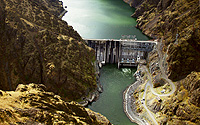forum
library
tutorial
contact

Dams Roil with Controversy
by Pat McCoyCapital Press, March 21, 2008
|
the film forum library tutorial contact |

|
Dams Roil with Controversyby Pat McCoyCapital Press, March 21, 2008 |
Federal scheme nixed for high dam
 BOISE - Reintroduced wolves, the Teton Dam failure, the early 20th century trial of those accused of assassinating former Gov. Frank Steunenberg - Idaho isn't lacking in events that attract the national spotlight.
BOISE - Reintroduced wolves, the Teton Dam failure, the early 20th century trial of those accused of assassinating former Gov. Frank Steunenberg - Idaho isn't lacking in events that attract the national spotlight.
One such event, half forgotten today, occurred in August 1952. World War II hero Gen. Dwight D. Eisenhower chose Boise as the podium from which to make his first official speech as the Republican nominee for president of the United States.
The speech, delivered on the steps of Idaho's Statehouse, drew one of the largest audiences ever seen in Idaho. It was so huge news reporters and police dealing with crowd control wouldn't even attempt to estimate its size.
Even those who vaguely remember the event have likely forgotten the topic of Ike's speech - federal proposals for a high dam in Hells Canyon.
The proposed dam was the focus of intense national debate at the time, said Karl Brooks, associate professor of history and environmental studies at the University of Kansas.
A former Idaho state legislator, Brooks said the debate ended in favor of three much smaller dams, built and owned by Idaho Power Co. Irrigators lined up solidly behind IPCo., a support that lasted until the Swan Falls controversy of the 1970s - which ultimately launched Idaho's massive Snake River Basin Adjudication -sharply divided them.
"The proposed high dam was seen as surrendering the river to federal control, eroding the prior appropriation doctrine which governs water rights in most Western states. Eisenhower opposed it, in favor of local control," he told the Idaho Environmental Forum in a March 13 speech.
"The controversy really began in 1932, when Franklin D. Roosevelt visited Portland and promised to dam the Columbia River," said Brooks. "He kept that promise, bringing industry to the Northwest. Prior to that time, it was one of the most rural and economically depressed regions in the nation."
President Harry Truman tried to deliver on the balance of Roosevelt's promise, asking Congress to authorize the Hells Canyon high dam. The debate, and Eisenhower's speech on the subject, made the election of 1952 a referendum on what would happen to the New Deal following World War II, he said.
The proposed federal project would have been about 940 feet tall, about three times the height of the tallest IPCo. structure. That would have made it taller than Hoover Dam and capable of generating more electricity than Grand Coulee Dam.
"Eisenhower's election began to end the controversy. In the late 1960s, the U.S. Supreme Court issued a ruling that turned down the last efforts by the federal government to build a high dam," Brooks said. "If it had been built, Southern Idaho would have developed in a much more urban, industrialized way than it ultimately did. State residents at that time were solidly committed to irrigation."
Former Rep. Gracie Pfost, a liberal Democrat who represented Idaho in the U.S. House from 1953 to 1963, worked tirelessly to build the high dam, he said.
At the time one of the few women in Congress, Pfost represented a Democratic Party that's gone today, one favoring big federal investments and big projects.
"Idaho Power's T. E. Roach complex, named for the company president at the time, was built from 1955 to 1963. Building the low dams probably kept the federal agencies out of the Salmon and other areas of Idaho," he said.
Brooks wrote a book on the controversy, "Public Power, Private Dams," which he made available to luncheon attendees.
learn more on topics covered in the film
see the video
read the script
learn the songs
discussion forum
